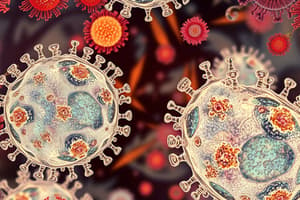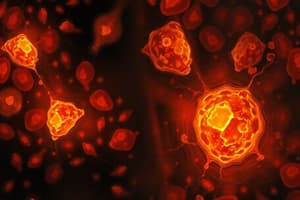Podcast
Questions and Answers
What are the three signals required for full T cell activation?
What are the three signals required for full T cell activation?
- TCR-ligation by MHC:Ag peptide complex, cytokine signal, and IL-2 production
- TCR-ligation by MHC:Ag peptide complex, accessory membrane molecules, and cytokine signal (correct)
- CD28 signal, cytokine signal, and TCR-ligation by MHC:Ag peptide complex
- Accessory membrane molecules, cytokine signal, and IL-2 production
Which transcription factor is activated by the calcineurin-dependent pathway?
Which transcription factor is activated by the calcineurin-dependent pathway?
- NF-kB
- NFAT (correct)
- CRE
- AP-1
Which pathway(s) is/are activated by the CD28 signal?
Which pathway(s) is/are activated by the CD28 signal?
- PI3K pathway only
- mTOR pathway only
- Both PI3K and mTOR pathways (correct)
- None of the above
How do corticosteroids exert their anti-inflammatory effect?
How do corticosteroids exert their anti-inflammatory effect?
Which anti-rejection drug works by blocking purine biosynthesis via both the de novo and salvage DNA pathways?
Which anti-rejection drug works by blocking purine biosynthesis via both the de novo and salvage DNA pathways?
Mycophenolate mofetil (MMF) specifically blocks which enzyme?
Mycophenolate mofetil (MMF) specifically blocks which enzyme?
How do calcineurin inhibitors affect T cell activation?
How do calcineurin inhibitors affect T cell activation?
Which anti-rejection drug directly inhibits the mTORC1 complex?
Which anti-rejection drug directly inhibits the mTORC1 complex?
What is the typical time frame for the onset of acute rejection after a transplant?
What is the typical time frame for the onset of acute rejection after a transplant?
What type of cells are involved in initiating an anti-graft immune response?
What type of cells are involved in initiating an anti-graft immune response?
What is the primary rationale for using anti-rejection drugs?
What is the primary rationale for using anti-rejection drugs?
Why are transplant patients typically prescribed a combination of 2/3 anti-rejection drugs?
Why are transplant patients typically prescribed a combination of 2/3 anti-rejection drugs?
How do induction therapy drugs affect the immune system?
How do induction therapy drugs affect the immune system?
What is the term for the type of immune response that occurs when a person's immune system reacts against donated tissue?
What is the term for the type of immune response that occurs when a person's immune system reacts against donated tissue?
What role do cytokines play in allograft rejection?
What role do cytokines play in allograft rejection?
What is the role of donor dendritic cells (DCs) in allograft rejection?
What is the role of donor dendritic cells (DCs) in allograft rejection?
What is the primary mechanism of action of Cyclosporin A (CsA) in T cells?
What is the primary mechanism of action of Cyclosporin A (CsA) in T cells?
Which of the following cytokines is notably downregulated by calcineurin inhibitors?
Which of the following cytokines is notably downregulated by calcineurin inhibitors?
What is the role of Rapamycin (Sirolimus) in T cell modulation?
What is the role of Rapamycin (Sirolimus) in T cell modulation?
Which therapy is classified as a co-stimulation blockade approach in T cell inhibition?
Which therapy is classified as a co-stimulation blockade approach in T cell inhibition?
What is a significant advantage of mTOR inhibitors compared to calcineurin inhibitors?
What is a significant advantage of mTOR inhibitors compared to calcineurin inhibitors?
Which of the following is a key component of induction therapy for transplant rejection?
Which of the following is a key component of induction therapy for transplant rejection?
Anti-CD25 antibodies specifically target which molecule on T cells?
Anti-CD25 antibodies specifically target which molecule on T cells?
What does the co-stimulation blockade via CTLA-4 aim to prevent?
What does the co-stimulation blockade via CTLA-4 aim to prevent?
Flashcards
Graft Rejection
Graft Rejection
The process where the body's immune system attacks a transplanted organ, leading to its damage and failure.
Anti-rejection drugs
Anti-rejection drugs
Drugs used to suppress the immune system to prevent graft rejection, allowing the transplanted organ to survive.
Induction therapy
Induction therapy
Therapy provided immediately after transplantation, aiming to quickly suppress the immune system to prevent early rejection.
Maintenance therapy
Maintenance therapy
Signup and view all the flashcards
Acute rejection
Acute rejection
Signup and view all the flashcards
Chronic rejection
Chronic rejection
Signup and view all the flashcards
Broad immunosuppressants
Broad immunosuppressants
Signup and view all the flashcards
Selective immunosuppressants
Selective immunosuppressants
Signup and view all the flashcards
Calcineurin Inhibitors (CnIs)
Calcineurin Inhibitors (CnIs)
Signup and view all the flashcards
mTOR inhibitors
mTOR inhibitors
Signup and view all the flashcards
Cyclosporin A (CsA)
Cyclosporin A (CsA)
Signup and view all the flashcards
Tacrolimus (FK506)
Tacrolimus (FK506)
Signup and view all the flashcards
Rapamycin (Sirolimus)
Rapamycin (Sirolimus)
Signup and view all the flashcards
Antibody-based anti-rejection therapies
Antibody-based anti-rejection therapies
Signup and view all the flashcards
Anti-CD25 antibodies
Anti-CD25 antibodies
Signup and view all the flashcards
Belatacept
Belatacept
Signup and view all the flashcards
T Cell Activation Signals
T Cell Activation Signals
Signup and view all the flashcards
What is the Immunological Synapse?
What is the Immunological Synapse?
Signup and view all the flashcards
What is the role of Calcineurin in T cell activation?
What is the role of Calcineurin in T cell activation?
Signup and view all the flashcards
How do Corticosteroids work?
How do Corticosteroids work?
Signup and view all the flashcards
What is Azathioprine used for?
What is Azathioprine used for?
Signup and view all the flashcards
What is MMF and how does it work?
What is MMF and how does it work?
Signup and view all the flashcards
What do Calcineurin Inhibitors do?
What do Calcineurin Inhibitors do?
Signup and view all the flashcards
What are mTOR Inhibitors?
What are mTOR Inhibitors?
Signup and view all the flashcards
Study Notes
Transplantation Immunology
- Lecture 3 covered allograft rejection and anti-rejection strategies.
- Aims of the lecture included promoting awareness of anti-rejection therapies and understanding mechanisms of action of different anti-rejection drug classes.
- By the end of the session, students should have knowledge of various immunosuppressive drugs used in preventing graft rejection and understand effects of classical inhibitors on T cells.
Overview of Acute Rejection
- Organ transplantation triggers DAMP release causing an inflammatory environment. Cytokines are released, cells get activated, and HLA expression increases.
- Donor dendritic cells (DCs) migrate to lymph nodes.
- Alloreactive T helper (TH) cells recognize donor HLA on antigen-presenting dendritic cells (APCs). These T cells proliferate (clonal expansion).
- Alloreactive TH cells then migrate to the graft. They are primed and activated, which triggers the release of cytokines. These cytokines drive rejection.
- Antibody-producing B cells are primed, resulting in anti-HLA antibodies targeting donor cells. This process involves antibody-dependent cellular cytotoxicity (ADCC).
- Ag-primed cytotoxic T lymphocytes (CTLs) destroy donor cells. CTLs target cells with HLA class I antigens. These often include endothelial cells and parenchymal cells
Prevention of Allograft Rejection - Introduction
- All vascularized allografts usually initiate an immune response against the graft.
- One or two HLA mismatches are sufficient to trigger rejection.
- Acute rejection starts within days of the transplant.
- Transplant recipients often require lifelong anti-rejection drugs to prevent chronic rejection
Prevention of Allograft Rejection - Anti-rejection Drugs
- Several classes of anti-rejection drugs exist, each with their unique mechanisms of action.
- Patients usually receive a combination of 2-3 anti-rejection drugs:
- Induction therapy: Used immediately after transplant to induce high immunosuppression.
- Maintenance therapy: A longer-term treatment.
- Anti-microbials are frequently required.
Anti-rejection Therapy - Rationale
- Anti-rejection drugs work by suppressing the immune system
- They target various aspects of immune cell function ranging from broad immunosuppression to selective targeting of signaling pathways involved in T-cell activation.
Activation of T Cells - General
- T cells need multiple signals for full activation.
- Activation is triggered by three main transcription factors: NFAT, NF-κB, and AP-1.
- The nature of the T cell response depends on the signals received:
- Signal 1: TCR binding to MHC-peptide complex.
- Signal 2: Accessory membrane molecules (e.g., CD28).
- Signal 3: Cytokine signals (e.g., IL-2).
The Immunological Synapse
- The diagram shows that the interaction between the T cell and the APCs generates signals that activate the T cell.
- TCR:CD3 signaling activates calcineurin and induces NFAT for T cell activation.
- CD28 signaling triggers PI3K and mTOR activation leading to activation of AP-1 and NF-κB.
- These signals coordinate for IL-2 production and T cell activation
Anti-inflammatory Agents - Corticosteroids
- Corticosteroids are lipophilic and bind to intracellular receptors.
- The receptor-steroid complex binds to DNA sequences (CREs), which results in:
- Production of lipomodulin; a phospholipase A2 inhibitor, decreasing arachidonic acid metabolism.
- Inhibiting cytokine gene expression, leading to immunosuppression.
Anti-Rejection Therapies - Antimetabolites
- Purine analogues: Azathioprine (AZA), a derivative of 6-mercaptopurine (6-MP).
- They block purine biosynthesis (an important process for DNA synthesis), mostly effective for primary response to renal grafts, and lowers steroid dosages.
Classical Anti-rejection Drugs - Antimetabolites
- Mycophenolate mofetil (MMF) blocks inosine monophosphate dehydrogenase, an enzyme essential to guanine synthesis.
- Its effectiveness is most prominent in acute rejection within 6 months post-transplant.
- An alternative to azathioprine if the patient doesn't tolerate it well.
Classical Anti-Rejection Drugs - Calcineurin Inhibitors
- Calcineurin inhibitors (Cnls) inhibit calcineurin-dependent intracellular pathways, primarily in T cells.
- They down regulate cytokine gene transcription particularly IL-2 and its receptor IL-2R.
- They substantially reduce IL-2-induced T cell activation and maturation.
- Examples: Cyclosporin A (CSA), FK 506 (tacrolimus).
Classical Anti-Rejection Drugs - mTOR Inhibitors
- mTOR inhibitors (e.g., rapamycin/sirolimus, everolimus) bind to intracellular FKBP12.
- Rapamycin/sirolimus/everolimus bind with intracellular FKBP12 to prevent activation of mTOR.
- mTOR activity is reduced as a result, leading to reduced T-cell proliferation.
- They have less nephrotoxicity than calcineurin inhibitors (Cnls).
Selective Inhibition of Signaling Pathways in T Cells
- The diagram illustrates how these drugs impact T cells.
- Some drugs alter pathways related to calcineurin. others to mTOR, some to CD28.
- The graph and diagrams display how these inhibitors affect T cell pathways in detail.
Antibody-based (Specific) Anti-rejection Therapies
- Antibodies are used as induction therapy.
- Antilymphocyte globulin (ALG) and anti-thymocyte globulin (ATG) are commonly used.
- Reducing lymphocyte and T-cell activity.
- Anti-CD3, anti-CD25 (IL-2Rα), and anti-CD20 antibodies are used to target specific cells.
Co-stimulation Blockade of T Cells
- Belatacept is a recently introduced anti-rejection drug.
- It is an immunoglobulin G (Ig) fused to CTLA-4 (CD152).
- Belatacept binds to CD80/86 on antigen-presenting cells (APCs) preventing the binding of CD28 and significantly reduced T-cell activity.
Summary
- Suppressing alloreactive T-cells is needed due to rejection in most cases of allografts.
- Cytotoxic drugs are broad spectrum immune suppressants, but also exceptionally harmful to patients.
- Calcineurin inhibitors (CNI) and mTOR inhibitors are more selective therapies to inhibit T-cell activation.
- Combining CNIs and mTor inhibitors are used across varied phases of transplantation (induction and maintenance).
- mTOR inhibitors have notably less kidney toxicity than calcineurin inhibitors.
Studying That Suits You
Use AI to generate personalized quizzes and flashcards to suit your learning preferences.




![Lecture 06: T-cells and B-cell activation [MCQ 2]](https://assets.quizgecko.com/cdn-cgi/image/width=300,height=200,fit=crop,quality=75,format=webp/quiz/3a994686d8bf59d60d02fc2aa264f493.jpg)